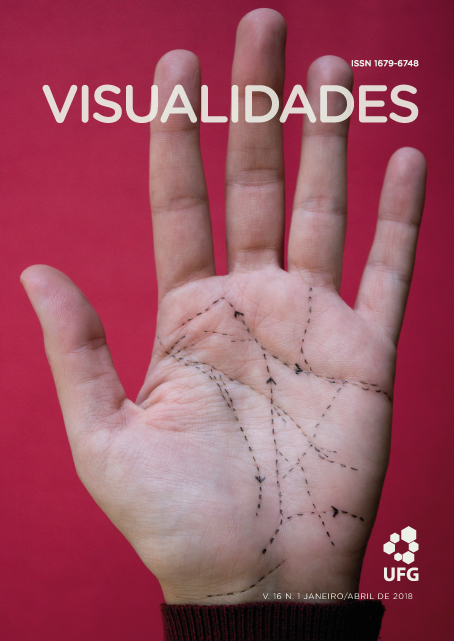O Sétimo Selo, de Ingmar Bergman, e as bases metafísicas da ciência moderna
DOI:
https://doi.org/10.5216/vis.v16i1.45910Keywords:
cinema, percepção da ciência, metafísicaAbstract
Exploring the potential of cinema to make the spectator see what transcends the representation and even spectator's perceptive field, The Seventh Seal, directed by Ingmar Bergman, through connections more thematic than audiovisuals, guides the analysis of the relations between metaphysical foundations of modern science and the construction of the opposition between culture and civilization. Other films support the analysis that begins with the triumph of Isaac Newton's gravitational theory toward the large spectrum of visual perceptions about Western culture offered by The Seventh Seal, from the Genesis to the Apocalypse, from the dawn of modern science to the atomic bomb.
Downloads
References
BARBARAS, Renaud. Investigações Fenomenológicas: em direção a uma fenomenologia da vida. Curitiba: Editora da UFPR, 2011.
BARRETO, Márcio. Por Que Revisitar o Debate entre Bergson e Einstein? Trans/Form/Ação, Marília, v. 39, n. 1, p. 77-92, Jan/Mar, 2016.
BARTHES, Roland. La chambre clair. Paris: Gallimard, 1980.
BAUDRY, Jean-Louis. Le dispositif: approches metapsycologiques de l’impression de realité. Paris: Communications, 1975.
BERGSON, Henri. As duas fontes da moral e da religião. Rio de Janeiro: Zahar. Durée et Simultanéité. (1998). Paris: Quadridge/P.U.F., 1978.
____________ Durée et Simultanéité. Paris: Quadridge/P.U.F., 1999.
____________ A Evolução Criadora. Lisboa, Edições 70, 2001.
CABRERA, Julio. O cinema pensa. Uma introdução à filosofia através dos filmes. Rio de Janeiro: Rocco, 2006
COPÉRNICO, Nicolau. As Revoluções dos Orbes Celestes. 1ª edição, Lisboa: Fundação Calouste Gunbenkian, 1984.
DELEUZE, Gilles. Lógica do sentido. São Paulo: Perspectiva, 1974.
____________ Cinema 1: A imagem-movimento. São Paulo: Brasiliense, 1983.
____________Cinema 2: a imagem-tempo. São Paulo: Brasiliense, 2005.
DOBB'S Betty. The Foundations of Newton's Alchemy. New York: Cambridge University Press, 1984.
JUNG, Carl Gustav. Os arquétipos e o inconsciente coletivo. Petrópolis: Vozes, 2000.
KEYNES, John Maynard. Newton, The Man. In: Essays in Biography. London: The Macmillan Press Ltd., 1972.
KOPENAWA, Davi. Depoimento recolhido, traduzido do Yanomami e editado por Bruce Albert, antropólogo do IRD (São Paulo-Paris). Catalogo da Conferência Brasil 500 anos, experiência e destino. A outra margem do Ocidente. São Paulo, FUNARTE – Instituto Cultural Itaú, 1998.
KOYRÉ, Alexandre. Études newtoniennes. Paris: Gallimard, 1968.
LAWRENCE, David Herbert. Apocalipse, seguido de O homem que morreu. São Paulo: Cia. das Letras, 1990.
MACHADO, Arlindo. Pré-cinema e pós-cinema. Campinas: Papirus, 2013.
NEWTON, Isaac. As Profecias de Daniel e o Apocalipse. Édipo: São Paulo, 1950.
NISHITANI, Keiji. Religion and nothingness. Berkley: University of California Press, 1982.
PRIGOGINE, Ilya. e STENGERS, Isabelle. A Nova Aliança. Brasília: Editora Universidade de Brasília, 1984.
RUMI, Mevlana. Masnavi. Buenos Aires: Dervish Ediciones, 1981.
SANTOS, Laymert Garcia dos. Lautréamont e o desejo de não desejar. In: Novaes, A. O desejo. São Paulo: Companhia das Letras, 1990.
SHAKESPEARE, William. Hamlet. Tradução de Millôr Fernandes. São Paulo: L & PM, 2011.
SIMONDON, Gilbert. Du mode d’existence des objets techniques. Paris, Aubier-Montaigne, 1969.
_____________ Sur la technique. Paris: Presses Universitaires de France, 2013.
TARKOVSKY, Andrei. Esculpir o tempo. São Paulo: Martins Fontes, 1990.
TRISMEGISTO, Hermes. Corpus Hermeticum. Discurso de iniciaçao a tabua de esmeralda. São Paulo: Hemus, 2001.
YATES, Francis. Giordano Bruno e a Tradição Hermética. São Paulo: Cultrix, 1987.
ZIZEK, Slavoj. Tout ce que vous avez toujours voulu savoir sur Lacan sans jamais oser le demander a Hitchcock. Paris: Navarian, 1988.
Downloads
Published
How to Cite
Issue
Section
License

This work is licensed under a Creative Commons Attribution 4.0 International License .
Authors who publish in this journal agree to the following terms:
a. Authors retain the copyright and grant the journal the right of first publication, with the work simultaneously licensed under the Creative Commons Attribution 4.0 License which allows the sharing of work with acknowledgment of authorship and initial publication in this journal.
b. Authors are authorized to take additional contracts separately, for non-exclusive distribution of the version of the work published in this journal (eg publish in institutional repository or as a book chapter), with acknowledgment of authorship and initial publication in this journal.
c. Authors are allowed to publish and distribute their work online (eg in institutional repositories or on their personal page) after the initial publication in this journal, as this can generate productive changes, as well as increase the impact and citation of the published work ( See The Effect of Free Access).
Every effort has been made to identify and credit the rights holders of the published images. If you have rights to any of these images and have not been correctly identified, please contact the Visuals magazine and we will publish the correction in one of the next issues.






